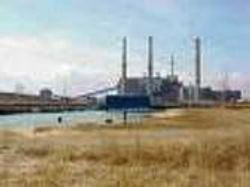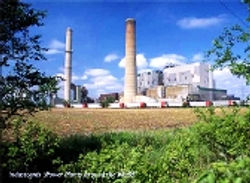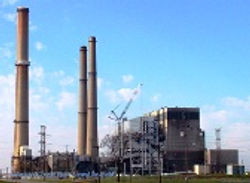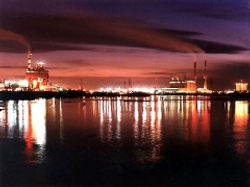
Fossil
 Waukegan |  Will County |  Powerton |
|---|---|---|
 Kincaid |  Joliet |
Kincaid Station Celebrates
50 Years of Service
Kincaid Generating Station, located about twenty miles southeast of Springfield, celebrated fifty years of service on October 6, 2017. Station Manager James Klenke hosted a luncheon attended by employees and around seventy retirees, including at least a dozen of the original station personnel who had put the units into service for the first time. About one hundred IBEW Local 15 members work at the station currently.
Commonwealth Edison Company started plans for Kincaid Station in 1963. The construction of Kincaid Station required over 13,500 tons of steel and about 64,000 cubic yards of concrete. Over 900 people worked at the site at the peak of activity. The cost of $100 million in 1967 would be equal to around $734 million in today’s money.
Sangchris Lake, the Station's source of water, was formed by building an earthen dam below the confluence of Clear Creek, a small three-fingered stream that flows into the South Fork of the Sangamon River. The lake has an area of 2,700 acres with a 120- mile shoreline and normally stores 35,000-acre-feet of water at full pool. A three-thousand acre State Park offers activities like camping, hiking, fishing, boating and hunting. Anglers lure bluegills, crappie, bass and catfish while hunters stalk waterfowl, deer, and squirrels in oak and maple forests.
The first of Kincaid's two 625,000 kilowatt generating units went on-line March 8, 1967, and commercial service started June 7, 1967. The second unit went commercial June 10, 1968. The station has generated more than 250 million gross megawatt hours over the last half century.
Kincaid Station was originally a mine-mouth plant to be supplied solely by Peabody Coal Company Mine No 10. Over 65 million tons of Peabody coal had been burned at Kincaid Station before pollution concerns forced the plant to switch to low sulfur high BTU western coal in 1995. In 1999 both units at Kincaid Station were converted to 100% low sulfur, low BTU Powder River Basin (PRB) coal. The switch to PRB coal resulted in no reduced megawatt capacity to either unit. Kincaid Station consumes approximately four million tons of PRB coal annually.
Commonwealth Edison sold Kincaid Station to Dominion Energy on February 27, 1998; who then sold the station to Energy Capital Partners in 2013; who then sold it to the present owners Dynegy in 2015.
The four cyclone-fired B&W boilers raise water temperature to 1005°F to make 4,200,000 pounds of steam per hour. There are fourteen cyclones on each boiler, each with its own silo that holds approximately sixty tons of coal. Sixty tons will last about three hours under ideal conditions. Average daily coal consumption for the station is 13,500 tons. The units must be fueled twenty-four hours every day as there are no bunkers for long term storage.
Coal is handled on dual conveyor and hammermill systems to feed both units on one system. The Westinghouse steam turbines turn hydrogen-cooled Westinghouse generators which are rated at 733MVA at 20kV making 660 megawatts of power.
Kincaid Station is connected to the PJM grid and transmits most of its electricity to the northern third of Illinois on two ComEd 345kV overhead transmission lines. Another two 345kV overhead transmission lines connect to Ameren in Pawnee and Pana, Illinois.



